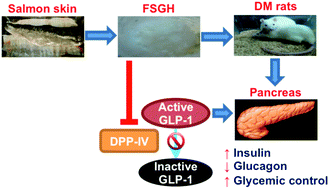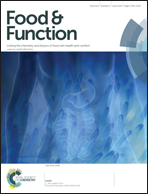Improvement of glycemic control in streptozotocin-induced diabetic rats by Atlantic salmon skin gelatin hydrolysate as the dipeptidyl-peptidase IV inhibitor
Abstract
In our previous study, Atlantic salmon skin gelatin hydrolysed with flavourzyme possessed 42.5% dipeptidyl-peptidase (DPP)-IV inhibitory activity at a concentration of 5 mg mL−1. The oral administration of the hydrolysate (FSGH) at a single dose of 300 mg per day in streptozotocin (STZ)-induced diabetic rats for 5 weeks was evaluated for its antidiabetic effect. During the 5-week experiment, body weight increased, and the food and water intake was reduced by FSGH in diabetic rats. The daily administration of FSGH for 5 weeks was effective for lowering the blood glucose levels of diabetic rats during an oral glucose tolerance test (OGTT). After the 5-week treatment, plasma DPP-IV activity was inhibited; the plasma activity of glucagon-like peptide-1 (GLP-1), insulin, and the insulin-to-glucagon ratio were increased by FSGH in diabetic rats. The results indicate that FSGH has the function of inhibiting GLP-1 degradation by DPP-IV, resulting in the enhancement of insulin secretion and improvement of glycemic control in STZ-induced diabetic rats.


 Please wait while we load your content...
Please wait while we load your content...